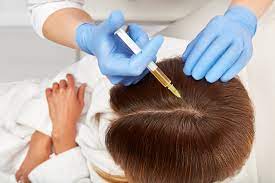Dermatologists play a crucial role in diagnosing and treating various forms of hair loss, medically known as alopecia. Whether the cause is genetic, hormonal, autoimmune, or related to other underlying conditions, dermatologists are trained to assess the root cause and recommend appropriate treatments.
Here’s how dermatologists can help with hair loss and the treatments they commonly offer:
- Diagnosis and Evaluation: Dermatologists begin by conducting a thorough evaluation of the patient’s medical history, family history, scalp examination, and sometimes blood tests or scalp biopsies to pinpoint the cause of hair loss. This comprehensive approach helps determine the most effective treatment plan tailored to the individual.
- Topical Treatments: Depending on the type and cause of hair loss, dermatologists may prescribe topical treatments such as minoxidil (Rogaine). Minoxidil is a vasodilator that promotes hair growth and is commonly used to treat pattern baldness (androgenetic alopecia) in both men and women.
- Oral Medications: In cases where topical treatments are not sufficient, oral medications such as finasteride (Propecia) may be recommended. Finasteride works by blocking the conversion of testosterone to dihydrotestosterone (DHT), a hormone that contributes to hair loss in genetically predisposed individuals.
- Intralesional Injections: For patients with localized hair loss conditions like alopecia areata, dermatologists may administer corticosteroid injections directly into the affected areas to suppress the immune response and stimulate hair regrowth.
- Platelet-Rich Plasma (PRP) Therapy: PRP therapy involves injecting a concentrated solution of the patient’s own platelets into the scalp to promote hair growth. This treatment is thought to stimulate hair follicles and improve hair density.
- Hair Transplantation: Dermatologists who specialize in hair restoration may perform hair transplantation procedures. This involves transplanting hair follicles from the donor area (usually the back or sides of the scalp) to the balding or thinning areas. Techniques such as follicular unit transplantation (FUT) or follicular unit extraction (FUE) are commonly used.
- Lifestyle Changes and Counseling: Dermatologists may also provide guidance on lifestyle changes that can promote hair health, such as improving nutrition, managing stress, and avoiding harsh hair treatments that could contribute to hair loss.
- Scalp Treatments: Depending on the condition of the scalp, dermatologists may recommend treatments to improve scalp health, such as medicated shampoos or scalp massages to enhance circulation.
- Cosmetic Camouflage: In cases where hair loss cannot be fully reversed, dermatologists may suggest cosmetic solutions such as wigs, hairpieces, or camouflage products to improve the appearance of thinning hair.
In conclusion, dermatologists are invaluable in diagnosing the underlying causes of hair loss and providing effective treatments to help patients restore hair growth and maintain scalp health. Treatment plans are personalized based on the type and severity of hair loss, ensuring that patients receive comprehensive care and achieve the best possible outcomes. Early consultation with a dermatologist is key to addressing hair loss effectively and preserving hair quality and density over time.





Comments